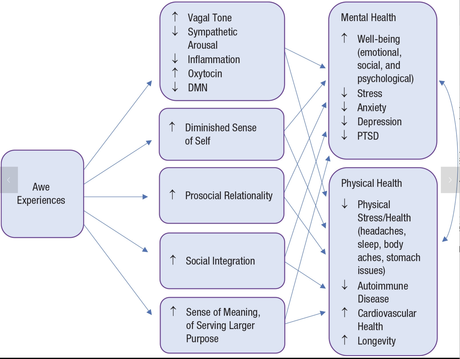Reading
this open source review from Maria Monroy and Dacher Keltner leaves me feeling substantially more mellow! Their abstract, followed by a quote from Emerson, and then a summary graphic...
How do experiences in nature or in spiritual contemplation or in being moved by music or with psychedelics promote mental and physical health? Our proposal in this article is awe. To make this argument, we first review recent advances in the scientific study of awe, an emotion often considered ineffable and beyond measurement. Awe engages five processes—shifts in neurophysiology, a diminished focus on the self, increased prosocial relationality, greater social integration, and a heightened sense of meaning—that benefit well-being. We then apply this model to illuminate how experiences of awe that arise in nature, spirituality, music, collective movement, and psychedelics strengthen the mind and body.
and,
In the woods, we return to reason and faith. There I feel that nothing can befall me in life—no disgrace, no calamity (leaving me my eyes), which nature cannot repair. Standing on the bare ground—my head bathed by the blithe air and uplifted into infinite space—all mean egotism vanishes. I become a transparent eyeball; I am nothing; I see all; the currents of the Universal Being circulate through me; I am part or parcel of God. The name of the nearest friend sounds then foreign and accidental; to be brothers, to be acquaintances, master or servant, is then a trifle and a disturbance. I am the lover of uncontained and immortal beauty.
-from Emerson R. W. (1836). Nature. Reprinted in Ralph Waldo Emerson, Nature and Other Essays (2009). Dover.

Fig. 1. Model for awe as a pathway to mental and physical health. This model shows that awe experiences will lead to the mediators that will lead to better mental and physical-health outcomes. Note that the relationships between awe experiences and mediators, and mediators and outcomes have been empirically identified; the entire pathways have only recently begun to be tested. One-headed arrows suggest directional relationships, and two-headed arrows suggest bidirectionality. DMN = default-mode network; PTSD = posttraumatic stress disorder.


